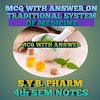INTRODUCTION OF MICROBIOLOGY
TOPICS COVERED
WHAT IS MICROBIOLOGY
WHAT IS MEAN BY MICRO-ORGANISM
BRANCHES OF MICROBIOLOGY
DEFINITION OF MICROBIOLOGY:-
Microbiology is a branch of science that deals with the study of microscopic forms of life.(Microscopic forms of life are nothing but micro-organism which includes bacteria, fungi (yeast and molds), protozoa, algae, and viruses.
WHAT IS MICROORGANISM:-
Microorganisms are those living things that are too small in size (i.e. 0.1 micrometer to 2 micrometer.), They cannot be seen by naked eyes, they are only seen under the microscope.
Microorganisms are present everywhere in nature, Examples atmosphere (Air), soil, water, human beings, animals, plants and food. Microorganisms may be beneficial or harmful to human beings.
They may be multicellular or unicellular, prokaryotic or eukaryotic, motile or non motile, aerobic or anaerobic nature.
The microbiology is concerned with study of microorganism which include:-
Classification of microorganism
Distribution in nature
Structure of microorganism
Reproduction
Metabolism and
Physiology
PURE MICROBIOLOGY:- Pure microbiology deals with the study about the structure, form, reproduction, physiology, metabolism and classification of almost all the microorganisms, separately and specifically at higher level. Pure microbiology have 14 sub branches
- Bacteriology: The study of bacteria.
- Mycology: Study of fungi.
- Phycology/algology: Study of algae
- Protozoology: Study of protozoa
- Parasitology: Study of parasites
- Virology: Study of viruses
- Nematology: Study of nematodes
- Microbial cytology: it is the study of microscopic and sub-microscopic details of microorganisms.
- Microbial ecology: It is the study of relationship between microorganisms and their environment.
- Microbial genetics: It is the study of how genes are organized and regulated in microbes in relation to their cellular functions closely related to the field of molecular biology.
- Molecular microbiology: It is the study of the molecular principles of the physiological processes in microorganisms.
- Phylogeny: The study of the genetic relationships between different organisms. Immunology: the study of the immune system.
- Cellular microbiology: A discipline bridging microbiology and cell biology.
- Immunology: Study of immune system.
APPLIED MICROBIOLOGY:- Applied microbiology deals with the study of microorganism in different industrial and agricultural fields, in order to serve mankind by simply providing a valuable knowledge and products from the use of microorganism. Applied microbiology have 9 sub branches..
Medical microbiology: In medical microbiology study is carried out on pathogenic microbes and the role of microbes in human illness. causative agent of disease, identification, pathogenecity, prevention & cure of disease.
Pharmaceutical microbiology: It is the study of microorganism that are related to the production of antibiotics, enzymes, vitamins, vaccine and other pharmaceutical products. And also the study of micro-organism that cause pharmaceutical contamination and spoil.
Microbial biotechnology: the manipulation of microorganisms at the genetic and molecular level to generate useful products such as antibiotics, enzymes, amino acid.
Food microbiology: Study of microorganisms associated with foods such as using microorganism to produce foods (E.g. by fermentation) Also study of microorganisms causing food, spoilage spread infection & food borne illness.
Water microbiology: Study of those microorganisms that are found in nature. Also called as aquatic microbiology.
Industrial microbiology: It is the branch of microbiology that deals with conversion of large amount of substrate into economically important product by use of microorganism. Microorganisms are used for production of various products like antibiotics, proteins, beverages, vaccine and food industries.
Environmental microbiology: It is the study of function and diversity of microbes in their natural environment.
Agriculture microbiology: Study of agriculture related microorganism (control plant disease & improve yields)
Aero microbiology: The study of air borne microorganism. Microorganism present in air are responsible for contamination of food & transmission of disease like tuberculosis, influenza, measles, small pox and also some plant & animal disease also spread through air.
Medical microbiology: In medical microbiology study is carried out on pathogenic microbes and the role of microbes in human illness. causative agent of disease, identification, pathogenecity, prevention & cure of disease.
Pharmaceutical microbiology: It is the study of microorganism that are related to the production of antibiotics, enzymes, vitamins, vaccine and other pharmaceutical products. And also the study of micro-organism that cause pharmaceutical contamination and spoil.
Microbial biotechnology: the manipulation of microorganisms at the genetic and molecular level to generate useful products such as antibiotics, enzymes, amino acid.
Food microbiology: Study of microorganisms associated with foods such as using microorganism to produce foods (E.g. by fermentation) Also study of microorganisms causing food, spoilage spread infection & food borne illness.
Water microbiology: Study of those microorganisms that are found in nature. Also called as aquatic microbiology.
Industrial microbiology: It is the branch of microbiology that deals with conversion of large amount of substrate into economically important product by use of microorganism. Microorganisms are used for production of various products like antibiotics, proteins, beverages, vaccine and food industries.
Environmental microbiology: It is the study of function and diversity of microbes in their natural environment.
Agriculture microbiology: Study of agriculture related microorganism (control plant disease & improve yields)
Aero microbiology: The study of air borne microorganism. Microorganism present in air are responsible for contamination of food & transmission of disease like tuberculosis, influenza, measles, small pox and also some plant & animal disease also spread through air.
CLICK BELOW TOPIC TO READ














2 Comments
Very good topic
ReplyDeleteIt's very helpful 👍
ReplyDeletePlease do not enter any spam link in the comment box.